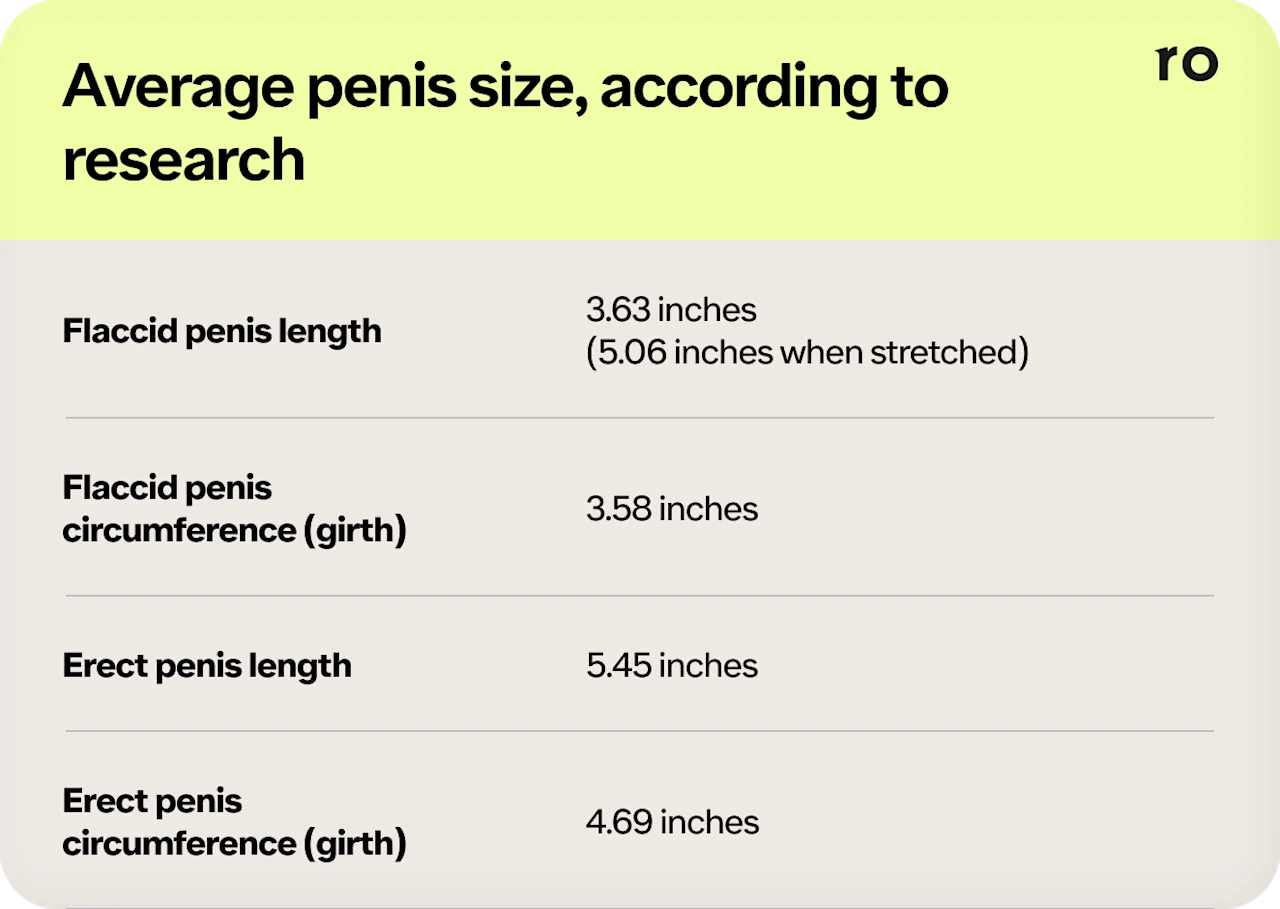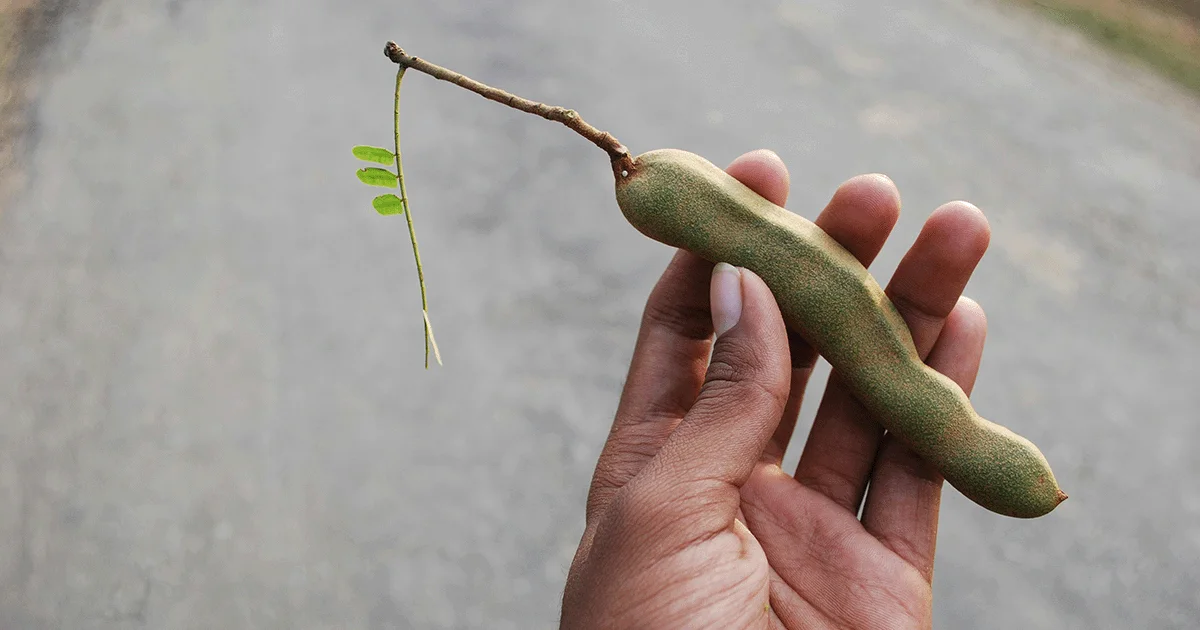Key takeaways
Most studies show women are happy with their partner’s penis size and don’t consider penis size to be very important. Other factors, such as the specific technique or position employed in bed, may even have more of an influence on their sexual pleasure.
Research suggests the average penis size is 3.63 inches when flaccid and 5.45 inches when hard. That’s smaller than what most men seem to think is the average measurement (over 6 inches).
If penis size is a major concern for you, you might be focusing on the wrong parts of your sexual performance and experience. In that case, simple strategies, such as improving your overall health, shaving your pubic hair, and even trying out new sex positions, may help make things more pleasurable. Discussing with your partner(s) can also help address your concerns.
Here's what we'll cover
Here's what we'll cover
Here's what we'll cover
Key takeaways
Most studies show women are happy with their partner’s penis size and don’t consider penis size to be very important. Other factors, such as the specific technique or position employed in bed, may even have more of an influence on their sexual pleasure.
Research suggests the average penis size is 3.63 inches when flaccid and 5.45 inches when hard. That’s smaller than what most men seem to think is the average measurement (over 6 inches).
If penis size is a major concern for you, you might be focusing on the wrong parts of your sexual performance and experience. In that case, simple strategies, such as improving your overall health, shaving your pubic hair, and even trying out new sex positions, may help make things more pleasurable. Discussing with your partner(s) can also help address your concerns.
Let’s get something out of the way: There’s no perfect penis size, and if you’re wondering, “what size penis do women prefer?” the answer might be smaller than you think.
Many people with penises (for the remainder of this article, we’ll refer to these people as men, but we are including anyone who has a penis) worry about whether they’re “big enough.” We’re here to tell you the research shows you probably are. Keep reading to get the full low-down on penis size preferences, how to measure your member, and more.
What penis size do women prefer, according to research?
Across pop culture, penis size has long been portrayed as the ultimate ticket to female pleasure and approval. But here’s the thing: There’s no one penis size that women prefer. And that’s because everyone’s different.
Now, just because some folks might be fond of a larger member and some might favor a smaller one, doesn’t mean researchers haven’t tried to nail down the ideal penis size. So, what did they find? That an erect penis coming in at just over 6 inches in length and about 5 inches in girth seems to be the preferred down-there dimensions among women.
In a small study, heterosexual women were tasked with choosing a preferred penis size based on 3D-printed models of penises, ranging in length from 4 inches to 8.5 inches, and in circumference (aka girth) from 2.5 inches to 7 inches. The study participants preferred, on average, an erect length of 6.3 inches and girth of 4.8 inches for a long-term partner (compared to the slightly larger preference of 6.4 inches in length and 5 inches in girth for a one-time partner).
Those numbers are pretty in line with what most men consider to be the average penis size. As we’ll see in the next section, these numbers are slightly larger than the actual average penis size.
An important caveat is that this study was quite small, with only 75 women surveyed. More research is needed to get a better understanding of what women want when it comes to penis size.
One additional study is less detailed on inches, but showed that only 21% of women surveyed considered penis length to be of any importance to sexual satisfaction. About 32% considered girth to be important for sexual satisfaction. And a large study on over 50,000 people showed that 85% of women said they were satisfied with their male partner’s penis size.
While more research is needed to come to any definitive conclusions, these small studies indicate something important: If you’re a heterosexual man and you’ve wondered, “do women like big dicks?”, you’re probably more concerned about your penis size than your female partners.
What is considered a large penis?
In order to define what’s considered a large penis, we need to know what the average penis size is. After all, terms like “large” or “small” are relative (and often subjective). We’ll get into the details of the average penis size momentarily, but for now, all you need to know is the average is somewhere around 5 inches when erect.
That’s probably smaller than you thought, huh? If you’re like the majority of men, you’ve probably pegged the average penis size at over 6 inches. One thing is for sure: You don’t need to have a 9- or 10-inch penis to be considered “big,” despite what pornography and popular media might make you think. Anything over that 5-inch mark would be considered bigger than average.
What is the average penis size?
According to research, the average penis size is around 5 inches. But let’s dig a little deeper into these findings.
In 2025, researchers looked through 33 studies on penis size, with data on over 36,000 men from around the world. Here’s what they found for average flaccid and erect penis lengths and girths (aka circumference):
Flaccid penis length: 3.63 inches (5.06 inches when stretched)
Flaccid penis circumference: 3.58 inches
Erect penis length: 5.45 inches
Erect penis circumference: 4.69 inches
One fascinating piece of information to come out of another similar review study on over 55,000 men? The average erect penis length has increased by 24% over the past three decades. We don’t know why that would be, but if you’re worried about your penis length, there’s a chance your penis is larger than it might have been a generation or two ago.

What is a micropenis?
If your penis is smaller than these average measurements, you might be wondering if you have a micropenis. Odds are you don’t have one, given a micropenis is a clinical diagnosis that only affects about 1% of the population.
A true micropenis is diagnosed through a physical examination performed by a licensed healthcare provider. Some people define it with a specific numerical cutoff, while others define it compared to other people. Meaning, they may consider a micropenis to be defined as a penile length more than 2.5 standard deviations below the average for that individual’s age and race. This means less than 1% of the population would qualify as having a micropenis, by definition.
Worried you might have a true micropenis? Set up some time with a urologist to get the necessary testing. But before you do that, let’s make sure you’re measuring your penis correctly.
How to measure your penis — correctly
While you likely didn’t learn how to use a ruler down there in school, there is, in fact, a right way and a wrong way to measure your penis. Here’s the recommended way to get an accurate measurement of your penis:
How to measure penis length
To measure the length of your penis, you’ll need a rigid ruler or tape measure and an erect penis.
Position the measuring tool on top of your erect penis at the base, i.e. where it attaches to the pubic bone.
Press the end of the ruler into the pubic bone (past any hair or excess fat).
Measure in a straight line from the base to the head or tip of your penis (aka the glans).
How to measure penis girth
To measure the length of your penis, you’ll need a flexible tape measure and an erect penis.
Wrap the tape measure around the thickest part of the shaft of your penis; this is typically in the middle.
Note where the tape ends meet to determine your girth measurement.
It’s best to take a few measurements on different days and then average them to get the most accurate measurement.
Is there really a “perfect” penis size?
Nope, there is no perfect penis size. There are many factors involved in whether you’re able to have pleasurable sexual experiences, and penis size is just one piece of the puzzle. According to a small study, many consider emotional connection a much more significant factor in whether your female sexual partner deems sex with you as “great” or not, than the size of your penis.
Some women report that size does not matter regarding their sexual satisfaction. When asked whether length or girth is more important, it seems that penis girth likely plays a bigger role in how satisfied women feel after sex with a male partner than length.
You know what they say: “It’s not the size that matters, but how you use it.” Well, “they” might be onto something. A large survey study looked at different techniques women used to achieve orgasm through vaginal penetration, including angling, rocking, shallowing, and pairing. The most noteworthy technique in the context of this discussion about penis size is Shallowing, where shallow penetration (involving only the tip of the penis) actually helped more women achieve orgasm. That seems to imply that a bigger penis doesn’t necessarily equal more pleasurable sex. Bigger is not, in fact, always better.
Can you increase your penis size?
Don’t let those gas station tinctures and sketchy internet devices fool you. There is no real way to increase your penis size — at least not without major surgery, which no reputable surgeon will agree to perform, unless you meet very specific criteria.
All is not lost, though. If you’re worried about your penis size because you’re struggling to have (or give your partner) pleasurable sexual experiences, there are likely other factors at play. Making certain changes can boost your sexual function if these other elements are involved.
1. Communicate openly
You’ve heard it before, but it bears repeating: Communication is key when it comes to the health of your relationships. And sexual relationships are no exception. Better sexual communication has been shown to increase sexual satisfaction.
It’s important to keep the lines of communication open between you and your partner, so you both know what the other person likes and dislikes and how you can improve each other’s experience. As demonstrated in the research above, the way you move might make a bigger difference in your and your partner’s sexual pleasure than the size of your penis.
2. Treat erectile dysfunction
For some men, concerns about penis size are really more about function. If you’re consistently having trouble getting or maintaining an erection that’s strong enough for you and your partner to have a pleasurable sexual experience, erectile dysfunction (ED) might be to blame. But have no fear; help is available. All you need to do is consult your healthcare provider, who can determine what might be behind your down-there difficulties and the best treatment for you.
The most common course of action for addressing ED is prescription oral medication, such as Viagra (sildenafil) and Cialis (tadalafil) — both of which are part of a drug class called phosphodiesterase-5 (PDE5) inhibitors. Often considered first-line treatments, these medications work in part by helping blood flow into the penis and stay there, which is necessary for getting a hard erection. One thing to note: They only work when you’re aroused and stimulated, so they won’t give you an instant erection unless you’re in the mood.
You can also find certain PDE5 inhibitors in other formulations. For example:
Ro Sparks: a sublingual treatment that contains sildenafil and tadalafil, the active ingredients in Viagra and Cialis, respectively.
Daily Rise Gummies: a daily, fruit-flavored gummy featuring tadalafil.
While these two formulations are not specifically FDA-approved for the treatment of erectile dysfunction, their active ingredients have been FDA-approved for ED.
3. Eat a healthy diet
What you eat can significantly impact every part of your wellbeing, from how you perform at your job to how you perform in the bedroom.
While there’s no perfect diet — it’s all about finding what works best for you in a sustainable way — one scientific review showed that men who followed a Mediterranean diet had better sexual function than those eating a standard Western diet. A Mediterranean diet is primarily plant-based, with an emphasis on higher-quality proteins, while the standard Western diet is largely made up of ultra-processed foods. So, it’s not surprising that the former leads to better results than the latter.
4. Exercise regularly
Healthy erections primarily rely on healthy blood flow. And regular exercise is one of the best ways to improve blood flow throughout the body, including to the penis. One scientific review showed that regular exercise, especially aerobic exercise (e.g. walking, running, cycling), was correlated with better erectile function. So, if you’re concerned about your sexual performance, that’s one more reason not to skip the treadmill!
5. Lose weight if needed
Your weight, especially if you have overweight or obesity, can negatively impact your sexual function. Weight loss, however, can help alleviate those struggles.
First off, losing weight has been shown to improve erectile function in men with overweight who have ED. And second, excess weight around the belly and pubic bone might be making your penis look smaller than it is — a phenomenon that’s sometimes referred to as “buried penis syndrome.” Slimming down and, in turn, decreasing that excess fat may make your penis appear larger.
6. Shave your pubic hair
While your pubic hair (or lack thereof) won’t change the actual size of your penis, shaving it might give your penis a larger appearance. Up to one in five men say they trim or shave their pubic hair for this exact purpose.
7. Try different sexual techniques
Many men worry their penis size won’t let them penetrate deeply enough to satisfy their female partner, but it turns out, many women find greater satisfaction from a shallower penetration. In fact, as mentioned above, a study showed that “shallowing” — which involves penetration with only the tip of the penis — is one technique many women commonly use to reach orgasm faster.
But that’s just one example of ways you can use different moves and tactics to amp up the pleasure for you and your partner. Consider bringing toys into the bedroom
Another option? Bringing toys into the bedroom. But don’t forget the most important strategy of ‘em all: communicate, communicate, communicate.
8. Consider surgery as a last resort
If you have a true micropenis that is getting in the way of your performance in the bedroom, and nonsurgical approaches haven’t helped, speak with a urologist. Depending on the severity of your condition, surgery may be warranted. This might entail getting an implant or prosthetic, though approaches vary, and your healthcare provider is best equipped to run through the potential options with you. That being said, even for a micropenis, surgery is rarely recommended, comes with many potential complications, and should only be considered as a last resort.
Bottom line
So, what size penis do women like? Probably smaller than you think. Whether you’re worried about your member’s measurements or just curious about how yours might stack up, here’s what to keep in mind when it comes to penis size:
The vast majority of women say they’re satisfied with their partner’s penis size and penis size doesn’t matter much to them, at least according to research.
While most men think the average penis size is over 6 inches erect, research suggests the actual average penis size is under 5.50 inches when erect.
If you’re concerned about penis size, consider whether your worries may actually be stemming from issues with sexual performance — something you can address with strategies such as eating a healthy diet, exercising frequently, and even trying out different moves in the bedroom.
That being said, it’s always a good idea to consult a healthcare provider if you’re concerned about your penis size or function; they can determine what, if anything, might be going on down there and help get you back on track to feeling better in the bedroom, whether that’s by prescribing medications, such as those for ED, or suggesting specific lifestyle changes. Don’t forget to communicate with your sexual partner to figure out what works best for you (and them).
DISCLAIMER
If you have any medical questions or concerns, please talk to your healthcare provider. The articles on Health Guide are underpinned by peer-reviewed research and information drawn from medical societies and governmental agencies. However, they are not a substitute for professional medical advice, diagnosis, or treatment.
Viagra Important Safety Information: Read more about serious warnings and safety info.
Cialis Important Safety Information: Read more about serious warnings and safety info.
References
Almuqahwi, A., Alabdrabulridha, H., Aljumaiah, R. M., et al. (2023). A systematic review on the relationship between physical activity and sexual function in adults. Cureus, 15(12), e51307. doi: 10.7759/cureus.51307. Retrieved from https://pmc.ncbi.nlm.nih.gov/articles/PMC10823211
Alsaleem, M. & Saadeh, L. (2023). Micropenis. StatPearls. Retrieved on May 29, 2025 from https://www.ncbi.nlm.nih.gov/books/NBK562275/
Belladelli, F., Del Giudice, F., Glover, F., et al. (2023). Worldwide temporal trends in penile length: a systematic review and meta-analysis. World Journal of Men's Health, 41(4), 848-860. doi: 10.5534/wjmh.220203. Retrieved from https://pubmed.ncbi.nlm.nih.gov/36792094/
Dhaliwal, A. & Gupta, M. (2023). PDE5 inhibitors. StatPearls. Retrieved on May 29, 2025 from https://www.ncbi.nlm.nih.gov/books/NBK549843/
Francken, A. B., van de Wiel, H. B. M., van Driel, M. F., et al. (2002). What importance do women attribute to the size of the penis? European Urology, 42(5), 426-431. doi: 10.1016/S0302-2838(02)00396-2. Retrieved from https://www.europeanurology.com/article/S0302-2838(02)00396-2/abstract
Gaither, T. W., Awad, M. A., Osterberg, E. C., et al. (2017). Prevalence and motivation: pubic hair grooming among men in the United States. American Journal of Men's Health, 11(3), 620–640. doi: 10.1177/1557988316661315. Retrieved from https://pmc.ncbi.nlm.nih.gov/articles/PMC5675231/
Habous, M., Muir, G., Soliman, T., et al. (2018). Outcomes of variation in technique and variation in accuracy of measurement in penile length measurement. International Journal of Impotence Research, 30(1), 21–26. doi: 10.1038/s41443-017-0013-3. Retrieved from https://www.nature.com/articles/s41443-017-0013-3
Hensel, D. J., von Hippel, C. D., Lapage, C. C., & Perkins, R. H. (2021). Women's techniques for making vaginal penetration more pleasurable: Results from a nationally representative study of adult women in the United States. PloS One, 16(4), e0249242. doi: 10.1371/journal.pone.0249242. Retrieved from https://pmc.ncbi.nlm.nih.gov/articles/PMC10364113/
King, B. M. (2021). Average-size erect penis: fiction, fact, and the need for counseling. Journal of Sex and Marital Therapy, 47(1), 80-89. doi: 10.1080/0092623X.2020.1787279. Retrieved from https://pubmed.ncbi.nlm.nih.gov/32666897/
La, J., Roberts, N. H., & Yafi, F. A. (2018). Diet and men's sexual health. Sexual Medicine Review, 6(1), 54-68. doi: 10.1016/j.sxmr.2017.07.004. Retrieved from https://pubmed.ncbi.nlm.nih.gov/28778698/
Lever, J., Frederick, D. A., & Peplau, L. A. (2006). Does size matter? Men's and women's views on penis size across the lifespan. Psychology of Men & Masculinity, 7(3), 129–143. doi: 10.1037/1524-9220.7.3.129. Retrieved from https://psycnet.apa.org/record/2006-09081-001
Marra, G., Drury, A., Tran, L., et al. (2020). Systematic review of surgical and nonsurgical interventions in normal men complaining of small penis size. Sexual Medicine Review, 8(1), 158-180. doi: 10.1016/j.sxmr.2019.01.004. Retrieved from https://pubmed.ncbi.nlm.nih.gov/31027932/
Mostafaei, H., Mori, K., Katayama, S., et al. (2025). A systematic review and meta-analysis of penis length and circumference according to who regions: who has the biggest one?. Urology Research & Practice, 50(5), 291–301. doi: 10.5152/tud.2025.24038. Retrieved from https://pmc.ncbi.nlm.nih.gov/articles/PMC11923605/
Prause, N., Park, J., Leung, S., & Miller, G. (2015). Women's preferences for penis size: a new research method using selection among 3d models. PloS One, 10(9), e0133079. doi: 10.1371/journal.pone.0133079. Retrieved from https://pmc.ncbi.nlm.nih.gov/articles/PMC4558040
Walker, A. M. & Lutmer, A. (2023). Caring, chemistry, and orgasms: components of great sexual experiences. Sexuality & Culture. Epub ahead of print. doi: 10.1007/s12119-023-10087-x. Retrieved from https://pubmed.ncbi.nlm.nih.gov/37360018/












